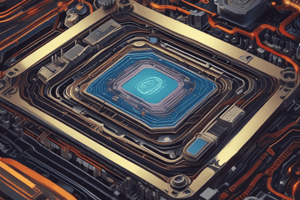Podcast
Questions and Answers
What is a primary method of cooling used in computers?
What is a primary method of cooling used in computers?
- Heat sinks
- Using water cooling systems
- Refrigeration units
- Utilizing cool air (correct)
How does the layout of components inside the computer case affect cooling?
How does the layout of components inside the computer case affect cooling?
- It has no impact on cooling whatsoever.
- It prevents airflow completely.
- It can obstruct airflow, affecting cooling performance. (correct)
- It enhances the cooling efficiency without additional fans.
What is a feature of high-end adapter cards used in computers regarding cooling?
What is a feature of high-end adapter cards used in computers regarding cooling?
- They do not require any cooling.
- They rely solely on passive cooling methods.
- They are designed to be quieter than standard cards.
- They often include their own built-in fan. (correct)
What can be a drawback of high-performance cooling systems with fans?
What can be a drawback of high-performance cooling systems with fans?
What is a potential advantage of using fan-controlled cooling systems?
What is a potential advantage of using fan-controlled cooling systems?
What cooling method do some compact computer systems utilize?
What cooling method do some compact computer systems utilize?
What is a disadvantage of replacing a loud fan with a quieter one?
What is a disadvantage of replacing a loud fan with a quieter one?
Which factor is crucial when installing fans in a computer system?
Which factor is crucial when installing fans in a computer system?
What is the primary function of a heat sink?
What is the primary function of a heat sink?
Which material is most commonly used to manufacture heat sinks?
Which material is most commonly used to manufacture heat sinks?
What is the recommended amount of thermal paste to apply on a CPU?
What is the recommended amount of thermal paste to apply on a CPU?
Which of the following best describes thermal paste?
Which of the following best describes thermal paste?
What is a key drawback of using thermal pads compared to thermal paste?
What is a key drawback of using thermal pads compared to thermal paste?
What is the primary benefit of adding a fan on top of a heat sink?
What is the primary benefit of adding a fan on top of a heat sink?
In which type of systems is liquid cooling most commonly found?
In which type of systems is liquid cooling most commonly found?
How does liquid cooling circulate the coolant?
How does liquid cooling circulate the coolant?
What is the purpose of the radiator in a liquid cooling system?
What is the purpose of the radiator in a liquid cooling system?
What tends to happen if a thermal connection between a CPU and heat sink is not efficient?
What tends to happen if a thermal connection between a CPU and heat sink is not efficient?
When is overclocking most likely to be performed on a computer system?
When is overclocking most likely to be performed on a computer system?
Why is it important to be cautious when working with a recently turned-off system?
Why is it important to be cautious when working with a recently turned-off system?
What happens to the thermal paste when a heat sink is removed?
What happens to the thermal paste when a heat sink is removed?
Which type of cooling method can provide a more compact and efficient solution than traditional air cooling?
Which type of cooling method can provide a more compact and efficient solution than traditional air cooling?
Flashcards
Computer Case Airflow
Computer Case Airflow
The process of moving cool air into a computer case and warm air out, to prevent overheating.
Heat Generating Components
Heat Generating Components
Components like video cards that generate a lot of heat and often have fans attached for cooling.
Fan Controller
Fan Controller
A device that controls the speed of fans in a computer system, allowing for adjustment of airflow and noise levels.
Passive Cooling
Passive Cooling
Signup and view all the flashcards
Computer Cooling
Computer Cooling
Signup and view all the flashcards
Computer Case Layout
Computer Case Layout
Signup and view all the flashcards
Airflow
Airflow
Signup and view all the flashcards
Active Cooling
Active Cooling
Signup and view all the flashcards
Heat sink
Heat sink
Signup and view all the flashcards
Thermal paste
Thermal paste
Signup and view all the flashcards
Thermal pad
Thermal pad
Signup and view all the flashcards
Liquid cooling
Liquid cooling
Signup and view all the flashcards
Radiator
Radiator
Signup and view all the flashcards
Thermal connection
Thermal connection
Signup and view all the flashcards
CPU block
CPU block
Signup and view all the flashcards
Fan-based cooling
Fan-based cooling
Signup and view all the flashcards
High thermal capacity
High thermal capacity
Signup and view all the flashcards
Surface area of a heat sink
Surface area of a heat sink
Signup and view all the flashcards
Overclocking
Overclocking
Signup and view all the flashcards
Noise level of a cooling system
Noise level of a cooling system
Signup and view all the flashcards
Reapplying thermal paste or pad
Reapplying thermal paste or pad
Signup and view all the flashcards
Choosing the right cooling solution
Choosing the right cooling solution
Signup and view all the flashcards
Study Notes
Computer Cooling Methods
- Air Cooling: Computers generate heat, necessitating cooling solutions. Cool air is drawn in, passes over heated components, and expelled as warmer air at the back of the system. This airflow depends on case design, motherboard type, and internal component layout.
- Fan Options: Multiple fans, varying sizes, and positioning flexibility can improve airflow. Motherboards often have fan controllers allowing adjustment of airflow intensity. Fans also differ in noise levels; potentially quieter alternatives exist.
- Passive Cooling: Certain systems, typically small ones, use passive cooling. These systems rely on heat sinks and lack fans. This is common in systems like small media servers designed to be near televisions.
- Heat Sinks: Heat sinks are metal (usually copper or aluminum alloy) with specialized shapes to absorb heat from components like CPUs and then dissipate it through air passing over them. They can be very hot, so care is needed when working on a system.
- Thermal Paste/Grease: This material forms a thermal interface layer between the heat sink and component. A pea-sized amount is typically used for CPUs to create uniform thermal conductivity. This optimal connection then directs heat away and into the cooling air.
- Thermal Pads: An alternative to thermal paste, these offer the same thermal interface connection, but require replacement each time the heat sink is removed. Pads are solid, cutting out any risk of leakage, and are useful in computer setups where thermal paste is impractical.
- Forced Air Cooling: Some heat sinks have fans directly mounted on them to enhance cooling. Large heat sinks paired with large fans are suitable for systems generating immense heat to dissipate it through multiple surface area and air volume.
- Liquid Cooling: Instead of air, some high-end systems including many gaming and graphics systems use liquid cooling. Cool water or liquid is circulated through a system of tubes, radiators, and pumps. Components use a cooling block in conjunction with a radiator which circulates cooler liquid back through the CPU. This is often used for systems where heat dissipation with water is preferred.
Studying That Suits You
Use AI to generate personalized quizzes and flashcards to suit your learning preferences.



